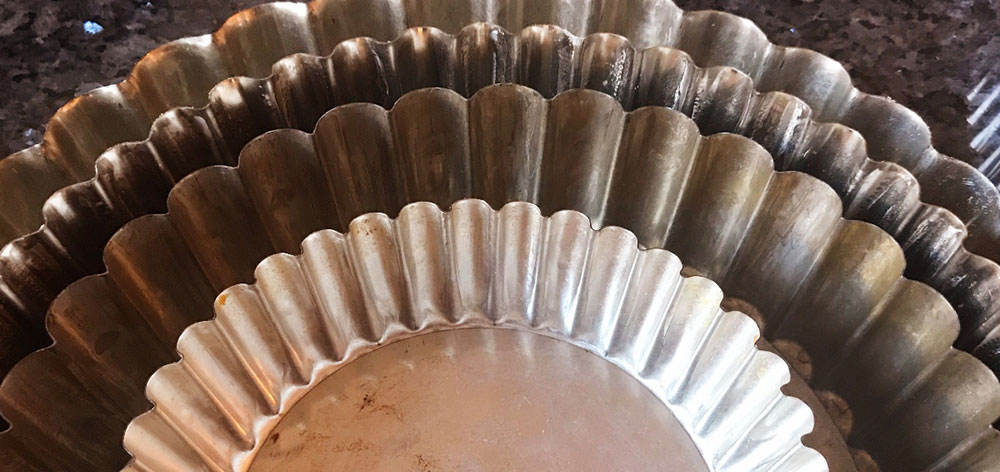
By Tatiana Pollard
THE WORLD CUP of winter eating is held in Europe every year, where it involves Christmas Eve, Christmas, Saint Stephen’s or Boxing Day, New Year’s Eve, New Year’s Day, and, aptly, Epiphany. Games start on December 24 and end on January 6. Let the best appetite win: lasagna or quiche?
Dinner of Champions: Lasagna or Quiche
After a holiday season of entertaining between eight and 12 people on a daily basis for two weeks, I have two well-tested cold-weather-dish formulas that have the additional benefit of warming up your house with a hot oven. These reliable not-really-recipes leave you enough room for creativity but also offer a no-fail zone of certainty. You can opt for whatever level of difficulty. One is French and one is Italian, and you wouldn’t likely think of them together—although Quiches and Lasagnas could easily be a cookbook title. Once prepped, each needs only about 45 minutes in a 360 F oven.
 Lasagna: A Middle-Ages Affair
Lasagna: A Middle-Ages Affair
First, some history, so you have something to talk about when you serve up your own version of this storied plate. Most people think of Bologna when it comes to lasagna, but the word has been traced back to a Latin term lasănum, meaning a type of cooking vessel, supposedly a tripod holding a pot, originally from the Greek word λάσανον. Written record of the L word can be found in two mediaeval cookbooks, both from the Neapolitan Anjou Court. Anonimo Meridionale, possibly drafted as early as the 1230s, includes a recipe titled “Affare lesagne.” One century later, a certain “De lasanis” is also mentioned in Liber de Coquina (of which two early 14th-century codices survive at the Bibliothèque Française in Paris). The most interesting research on the pasta shape and regional forms of lasagna can be found in Oretta Zanini De Vita’s Encyclopedia of Pasta.
Although Zanini De Vita might not agree with using store-bought lasagna sheets, you can find some fresh ones that have the paper-thin quality she claims the real dish must have. Or make your own; it keeps pretty well. If using fresh pasta, I generally don’t pre-cook it in boiling water, but rather prepare the dish with a more liquidy Béchamel sauce. These quantities were developed for a roasting pan that is about 24 x 34cm (9½ x 13 inches), but adapt as needed to whatever ceramic, metal or Pyrex casseroles you have.
Lasagna Procedure
For 250g (roughly half a pound, or 9 ounces) of lasagna sheets, make a Béchamel sauce by melting 100 grams of butter (7 tablespoons, or just under a stick) in a saucepan over a low flame and adding 80 grams of flour (a little less than 2/3 cup) and stirring it into a light-colored paste, then slowly adding a liter of milk (4¼ cups or 34 ounces), whisking continuously until a thick, spreadable sauce is formed. Here’s the creativity part: Open the refrigerator and see what must be used immediately. You need about 500 grams (18 ounces) of a main ingredient, such as a cooked vegetable or cured meat, and 600 grams (21 ounces) of cheese, plus Parmesan. Sautéed zucchini or artichoke hearts, boiled spinach and cooked peas are all great victims for your killer dish.
Spread Béchamel at the bottom of the pan, place a layer of pasta sheets on it, and sprinkle with meat or vegetable, pieces of the cheese, some more Béchamel and grated Parmesan. Repeat. The last layer is finished normally just with Béchamel, cheese, and perhaps a little of the leftover vegetable in decorative form. Don’t overload it. It’s all about finding balance between the quantity of pasta and the quantity of filling. Bake in a 360 F oven for about 45 minutes.
The most successful creations have been artichoke and asparagus lasagna with Taleggio and provolone; prosciutto cotto with Parmesan, mozzarella, and smoked scamorza; and spinach with ricotta and Parmesan. It’s a smart party dish that will feed between six and 10 people. You can make two smaller portions and then freeze after cooking if you wish to stock up for those evenings you don’t have time to cut, chop and cook.
Real Men Don’t Eat Quiche
For the conversation: Historical testimony of quiche does not reach as far back as the evolutionary origins of lasagna, but the word has been shaped across languages, too. It first appeared in the Lorraine dialect in the 1600s, in French in the early 1800s, and it hit English vocabularies in the 20th century. It is considered a relation of the German word Kuchen, or cake, which makes sense considering that Quiche Lorraine comes from an area that has seen both German and French rule. In its earliest forms the crust may have been leftover bread dough wrapped around a filling and baked off in the communal oven in times when personal ovens were not permitted under law in France. Your dinner guests might argue that savory pies with an egg cream can be found in Mediaeval Italian and English cookbooks, to which you might add that, yes, that’s true, but the term quiche is vastly better known – just consider this 1980s satirical book.
As for lasagna, you can up the ante by making your own pie crust, or ease the process with a pre-made one. Camille Glenn’s Flaky Butter Pastry from The Heritage of Southern Cooking is my go-to recipe, but if using a prepared crust I make sure it’s made from butter for better flavor. If making the dough myself, I usually bake it “blind” (with no filling) first. With store-bought, I don’t. See what works for you.
Quiche Procedure
Here’s what you’ll need in order to throw together a quiche. One pie crust or about 230 grams (8 ounces) of pastry. For the custard, three eggs and one cup milk (or even better, one cup cream). One to two cups of cooked vegetables and about the same amount of cheese. Whisk together eggs and cream with salt and pepper. Tuck the pastry into a 24 cm (9½-inch) round ceramic dish, or copper gratin or tart pan, and prick with a fork to avoid air bubbles. Spread a layer of vegetables and a layer of cheese (if a hard variety, grate it for easier melting) and pour the custard over it. The same leftovers you used above for your lasagna translate beautifully into a quiche. Bake in the oven for 45 minutes at 360 F.
(or even better, one cup cream). One to two cups of cooked vegetables and about the same amount of cheese. Whisk together eggs and cream with salt and pepper. Tuck the pastry into a 24 cm (9½-inch) round ceramic dish, or copper gratin or tart pan, and prick with a fork to avoid air bubbles. Spread a layer of vegetables and a layer of cheese (if a hard variety, grate it for easier melting) and pour the custard over it. The same leftovers you used above for your lasagna translate beautifully into a quiche. Bake in the oven for 45 minutes at 360 F.
Some hits have been sautéed fennel with Gruyère and black olives; braised onion or leek with a blue cheese like Gorgonzola or Stilton; spinach and smoked scamorza; or ricotta, cherry tomatoes, and basil. This quiche can serve about four people but can be easily doubled for a bigger crowd. Quiches don’t seem nearly as festive as lasagne, so pair it with a colorful salad.
Tatiana Pollard is daughter of Kitchen Detail’s Nancy Pollard, based in Bologna, the capital of Italy’s Emilia-Romagna region.


 Lasagna: A Middle-Ages Affair
Lasagna: A Middle-Ages Affair



Thank you for these new (to me) methods of making two staples to feed a crowd!